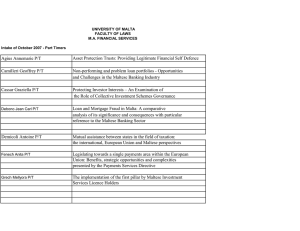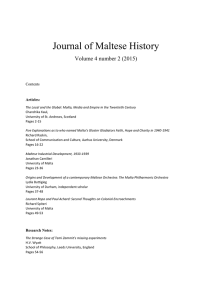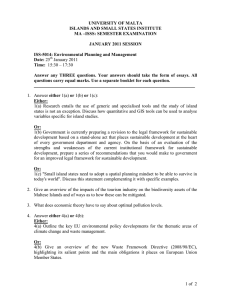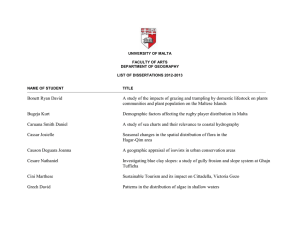War and population change in the Maltese context Charles Savona-Ventura Abstract
advertisement
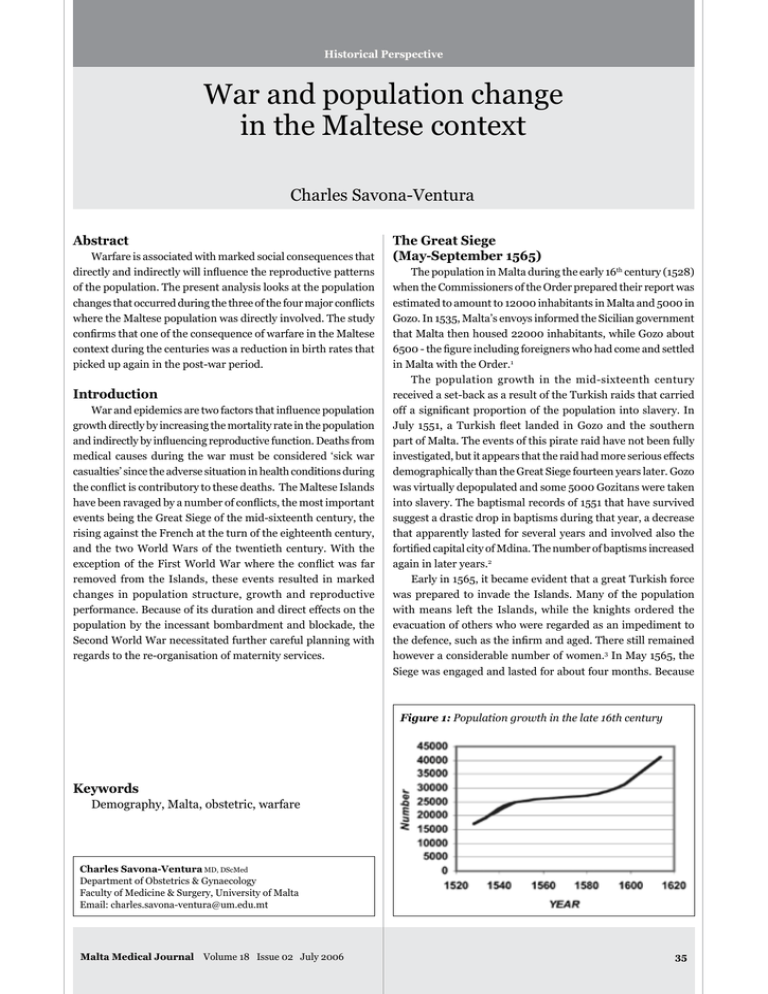
Historical Perspective War and population change in the Maltese context Charles Savona-Ventura Abstract Warfare is associated with marked social consequences that directly and indirectly will influence the reproductive patterns of the population. The present analysis looks at the population changes that occurred during the three of the four major conflicts where the Maltese population was directly involved. The study confirms that one of the consequence of warfare in the Maltese context during the centuries was a reduction in birth rates that picked up again in the post-war period. Introduction War and epidemics are two factors that influence population growth directly by increasing the mortality rate in the population and indirectly by influencing reproductive function. Deaths from medical causes during the war must be considered ‘sick war casualties’ since the adverse situation in health conditions during the conflict is contributory to these deaths. The Maltese Islands have been ravaged by a number of conflicts, the most important events being the Great Siege of the mid-sixteenth century, the rising against the French at the turn of the eighteenth century, and the two World Wars of the twentieth century. With the exception of the First World War where the conflict was far removed from the Islands, these events resulted in marked changes in population structure, growth and reproductive performance. Because of its duration and direct effects on the population by the incessant bombardment and blockade, the Second World War necessitated further careful planning with regards to the re-organisation of maternity services. The Great Siege (May-September 1565) The population in Malta during the early 16th century (1528) when the Commissioners of the Order prepared their report was estimated to amount to 12000 inhabitants in Malta and 5000 in Gozo. In 1535, Malta’s envoys informed the Sicilian government that Malta then housed 22000 inhabitants, while Gozo about 6500 - the figure including foreigners who had come and settled in Malta with the Order.1 The population growth in the mid-sixteenth century received a set-back as a result of the Turkish raids that carried off a significant proportion of the population into slavery. In July 1551, a Turkish fleet landed in Gozo and the southern part of Malta. The events of this pirate raid have not been fully investigated, but it appears that the raid had more serious effects demographically than the Great Siege fourteen years later. Gozo was virtually depopulated and some 5000 Gozitans were taken into slavery. The baptismal records of 1551 that have survived suggest a drastic drop in baptisms during that year, a decrease that apparently lasted for several years and involved also the fortified capital city of Mdina. The number of baptisms increased again in later years.2 Early in 1565, it became evident that a great Turkish force was prepared to invade the Islands. Many of the population with means left the Islands, while the knights ordered the evacuation of others who were regarded as an impediment to the defence, such as the infirm and aged. There still remained however a considerable number of women.3 In May 1565, the Siege was engaged and lasted for about four months. Because Figure 1: Population growth in the late 16th century Keywords Demography, Malta, obstetric, warfare Charles Savona-Ventura MD, DScMed Department of Obstetrics & Gynaecology Faculty of Medicine & Surgery, University of Malta Email: charles.savona-ventura@um.edu.mt Malta Medical Journal Volume 18 Issue 02 July 2006 35 Figure 2: Population counts turn of the 18th century Table 1: Civil events registration in Malta: 1796-1800 YearBaptisms Illegitimate Marriages Burials 1796 1797 1798 1799 1800 of the disruption in life, very few baptisms were recorded during this time, except at Mdina where many country people took refuge. Here baptismal records show the christenings of babies born to inhabitants of Dingli, Birkirkara, Naxxar, Zebbug, Mosta, Qormi, and Siggiewi. The disruption in the villages continued throughout the subsequent year. In 1567, the registers were again kept normally, and it is apparent that the number of baptisms in most villages did not differ significantly from those years before the Siege. It has been concluded from the available evidence, that the Siege fighting did not result in so many deaths that it fundamentally altered the structure of the local population. After 1568 significantly higher birth rates are revealed in the surviving baptismal records. By 1590, the total native population of the Islands, excluding the Order, its soldiers, servants and slaves, stood at 28864 inhabitants. By 1614 the population was estimated at 41084 excluding members of the Order (Figure 1).4 The Rising against the French (September 1798 - September 1800) The second major conflict that disrupted civil life in Malta occurred at the turn of the eighteenth century. In 1798, 3449 3629 3597 2237 3318 208 (6.0%) 214 (5.8%) 207 (5.8%) 167 (7.5%) 246 (7.4%) 722 (20.9%) 726 (20.0%) 465 (12.9%) 486 (21.7%) 844 (25.4%) 2276 2138 3030 8199 3869 Napoleon Bonaparte ousted the Knights of St. John from Malta. After only a few months, the Maltese rose against their French rulers and blockaded the garrison in the Grand Harbour fortified towns. The latter event disrupted civil life in Malta and resulted in marked changes in population structure, growth and reproductive performance. The civil strife and blockade lasted two years. Because the Maltese were poorly armed, they set out to starve the French. However the Islands were short of food and the conditions of the besiegers were little better than those of the besieged. The outcome of the struggle hinged solely on the food supply and the health of the two parties. Meanwhile disease and malnutrition took a toll of Maltese lives.5 This mortality is reflected in the population registered before and after the conflict. In 1797, before the rising, the status animarum for the diocese of Malta and Gozo estimated the population to number 96534 individuals, excluding the Order and its followers, with 3629 recorded baptisms. The live birth (sive baptisms) rate thus approximated 37.65 per 1000 civil population. During 1798, the population was estimated at 114000 total inhabitants. In 1807, the population numbered only 93054, a drop of 18.4% over the previous decade.6 This population drop was not due to direct war casualties, but due to famine and disease mitigated by a proportion of the population emigrating abroad with the departure of the Knights. A similar drop was registered in Gozo in spite of the fact that the strife in the sister island lasted only until October 1798. The population in Gozo in 1798 has been estimated at 16000 inhabitants. This figure fell by 19.8% over the subsequent decade so that the population in 1807 Figure 3: Population change and social parameters: 1796-1800 36 Malta Medical Journal Volume 18 Issue 02 July 2006 was estimated at 12829 (Figure 2).7 It as been estimated that during the strife, out of a population of 100000 souls, some 2000 perished through sickness and hunger, while direct war casualties amounted to just more than 300 men killed and wounded, some being killed prior to the uprising.8 Prior to the conflict there was little difference in the number of civil events registered annually. During the year of the conflict, there was a marked decrease in christenings from the 3597 figure in 1798 to 2237 in 1799. The number of baptisms in 1800 rose to 3318. During 1799-1800 in comparison to earlier years, a greater proportion of the registered baptisms were illegitimate. The number of marriages recorded in 1798 showed a marked decrease when compared to previous years. Marriages showed a subsequently surge in 1800. The death rate was also markedly raised in 1799 (Table 2; Figure 3).9 The First World War (1914-1918) The assassination of Archduke Francis Ferdinand and his wife at Sarajevo in June 1914 set the stage for the declaration of war that was to take worldwide proportions.10 During the First World War, the Central Mediterranean played a minor role since the major powers interested in the region -- England, France, and Italy -- were fighting on the same side. The Maltese Islands served as a “Nurse of the Mediterranean” caring for wounded soldiers, as a dockyard for the British Navy, as a place of internment for prisoners-of-war, and as a home for refugees from Egypt and other neighbouring countries. The War had however a major economic impact on the Islands. The disruption of trade reduced government revenue, food prices tended to rise in response to shortages and higher freight rates, with the result that the cost of living soon rose rapidly. The prices of bread, sugar, and meat were mostly affected in spite of the Government’s strict control of prices and a subsidy to millers. Black market was rampant. This economic depression, coupled with the departing men who joined the services, may have been contributory to the minor changes in demography that can be noted for the period.11 The war period showed little change in the population of the Maltese Islands with a slight rise from 211564 in the pre-war 1911 census to 212258 in the 1921 census. The rate of population growth was however affected by the conflict so that during intra-censal period 1911-1921 the rate of population growth was only 0.3%, a figure which is very much lower than the 14.5% rise noted in the previous inter-censal period 1901-1911. This low rise suggests that a significant deceleration in population growth was brought on by the social circumstances resulting from the war.12 The decreased population growth rate was the result of a fall in the birth rate recorded during the duration of the war. This showed a fall from a mean of 34.18 per 1000 population in the preceding years 1909-1913 to 30.45 during the war years, reaching its lowest level of 29.81 per 1000 population in 1917. There was subsequently a steady rise with a slight post-war boom reaching a maximum of 36.41 per 1000 population in 1922. The overall mean for the following five years 1919-1923 Figure 4: Maltese population 1909 - 1923 Figure 5: Birth rates: Maltese islands 1909-1923 Figure 6: Marriage [per 1000 population] and illegitimacy [per 1000 births] rates Maltese Islands 1909-1923 Figure 7: Crude death rates: Maltese islands 1909-1923 Malta Medical Journal Volume 18 Issue 02 July 2006 37 Figure 8: Stillbirth & late abortion rates: Maltese Islands 1909-1923 stood at 34.25 per 1000 population. The differences were more marked in Gozo where the lowest birth rate reached was 22.75 per 1000 population in 1917 (Figure 5).13 The diminution in the birth rate during the war is not surprising in view of the disturbance to family life brought on by the calling up of a large number of men to the services. About 20% of the total male population contributed to the war effort. A number of Maltese joined the voluntary corps of the British Empire on missions to various destinations, such as Salonica and Gallipoli. The Maltese Labour Corps provided Maltese stevedoring labour for unloading ships and for construction work at Suvla Bay and Gallipoli. Several individuals from the Royal Malta Artillery and the King’s Own Malta Regiment of Militia volunteered for services overseas, while there were also large numbers serving in the Royal Navy and the Royal Navy Reserve. The first Maltese corps were sent to the Dardanelles in September 1915, though individual men had joined the services earlier. The disruption in family life resulting from the departure of local male volunteers and the presence of a large number of foreign soldiers in the Islands did not appear to effect the illegitimacy rates during the war years. There did not appear to be any significant rise in illegitimacy rates during the war period suggesting that there was not a lowering of the moral standards of the strongly Roman Catholic population. The marriage rates showed a increase during the war period possibly reflecting hasty marriages prior to joining the fighting forces. The last year of the war until 1920 showed a marked drop in illegitimacy rates that rose to pre-war levels after 1921 (Figure 6).14 The crude death rates in the Maltese Islands showed only a minimal rise during the war period 1914-1918 to reach a maximum of 26.39 per 1000 population in 1918. The figures for Gozo showed a similar pattern, though the rates were generally lower and more fluctuant because of the smaller population there (Figure 7). Figure 9: Infant mortality rates: Maltese islands 1909-1923 38 Malta Medical Journal Volume 18 Issue 02 July 2006 Figure 10: Maternal Mortality Rate: Maltese Islands 1909-1923 The stillbirth & late abortion (Figure 8) rate showed a rise during the war years from a mean of 36.61 per 1000 total births in 1909-1913 (no data for 1910) to 40.25 in 1914-1918 (no data for 1914), reaching a peak rate of 55.39 in 1917. The rate subsequently reached a plateau and declined slightly in the post-war period averaging 46.40 per 1000 total births in 19191923. This gradual increase may reflect a deterioration in the socio-economic circumstances of the population brought on by the economic upheaval during the war years and after.15 The infant mortality rate showed a similar rise during the war years from a pre-war average of 240.57 per 1000 live births to 268.82 during the war. The rate returned to pre-war levels Table 2: Specific infant mortality rates (five-year averages per 1000 births) Infant Deaths Causes 1909-13 1914-18 1919-23 Diarrhoea Debility Atelectasis Birth Injury Prematurity Other early infancy causes Malformation Other causes 139.6 96.2 14.4 6.5 5.8 0.5 2.6 46.2 133.5 92.1 18.4 3.1 2.8 0.5 2.3 82.2 133.3 62.7 7.9 7.7 4.8 0.5 3.3 24.8 Table 3: Specific maternal mortality rates (five-year averages per 10000 births) Maternal Death Causes 1909-1913 1914-1918 1919-1923 Puerperal fever: Cases Puerperal fever: Deaths Hypertension: Deaths Haemorrhage: Deaths Other causes: Deaths 17.81 7.29 3.29 4.66 4.85 20.66 8.99 4.76 6.63 3.57 37.94 11.77 7.46 4.07 5.69 Malta Medical Journal Volume 18 Issue 02 July 2006 (249.62 per 1000 live births 1919-1923) after the end of the war (Figure 9). The reason for the rise in the infant mortality rate during the war years did not appear to be related to causes of early childhood which in fact actually decreased in most instances. The rise appeared to be due to other general causes of infant deaths (Table 2). The post-war period saw a significant improvement in most of the important causes of deaths of early childhood. Deaths from diarrhoea maintained the high rates recorded in previous periods.16 The maternal mortality rate showed a steady rise from the pre-war levels of 20.09 per 10000 total births to 23.954 during the 1914-1918 war years and 28.99 in the subsequent five years (Figure 10). The progressive rise in maternal mortality appeared to be the result of a significant rise in deaths from puerperal infection and hypertensive disease. The incidence of puerperal infection showed a similar progressive rise. The case fatality rates from sepsis appeared approximately stable in the first two periods decreasing in the post-war period. The case fatality rates were 41.7% in 1909-13, 43.5% in 1914-18 and 31.3% in 191923. Deaths from the complications of hypertensive disease of pregnancy showed a significant rise during the war years, a rise that persisted in the post-war period. Deaths from haemorrhage rose during the war years, but subsequently fell in the postwar period. Deaths from other causes (including accidents of childbirths and the puerperium, and embolism/sudden death) showed a variable pattern (Table 3).17 The early years of the twentieth century saw a number of problems gradually increasing the misery of the lower social classes in Malta. Illiteracy was rife and housing was primitive especially in the Harbour areas. The high pre-war unemployment, offset by the needs of the Dockyard and Services during the war, shot up again in the post-war period. The cost of living increased rapidly as a result of the War economy in spite of the fact that there was never any serious food shortage in Malta. Bread soared from its pre-war price of 21/2d per rotolo to 63/4d, sugar from 3d to 1s 2d, meat from 1s to 3s 6d. Everything else was affected except rent. The Government exercised strict 39 control on prices, organised distribution through its various boards and committees, allowed the sale of horseflesh and eventually subsidised the millers to the extent of £2000 per week to reduce the price of bread. All these factors contributed towards the deterioration in the social circumstances of the population, circumstances that partially contributed to the 7th June Riots by the Maltese in 1919. The post-war period saw the initiation by voluntary effort, assisted financially in part by the Civil Government, of efforts to adopt measures for promoting maternal and infant welfare. A society - Mothers and Infants Health Association - was formed in February 1919. The defined objectives of this association were (1) the holding of periodical meetings of mothers at which advice and simple class teaching would be given on the hygiene of infancy, on the feeding and clothing of infants, on prevention of disease and infant sick nursing; (2) the establishing of home visiting of mothers and infants by voluntary lady visitors; (3) the establishing of baby clinics to carry out free consultations, at which babies would be examined at regular intervals; (4) the helping of necessitous mothers with gifts of baby clothing, with milk and other infant foods at cost price or free; and (5) the provision of cheap meals to mothers who cannot get suitable and sufficient food at home. Three Consultation Clinics, at Hamrun, Valletta and Zejtun, were opened during 1919-20. These clinics offered supportive services to low economic status women in an attempt to lower the infant mortality rate. By 1926, the infant mortality rate was brought down to 260.8 per 1000 live births, while the stillbirth rate was 32.1 per 1000 total births. The maternal mortality rate was an estimated 38.7 per 10000 births.18 Conclusions Two types of warfare have been considered in this analysis. The first conflicts included pre-twentieth century direct conflicts where the population was directly involved fighting against foreign occupiers. The 16th century conflict involved a relatively high mortality rate in the arenas of the conflict - mortality that most likely involved mainly the combatants defending St. Elmo and St. Angelo-Birgu fortresses, and only minimally involved the lay population in other secure fortresses. This conflict was also of short duration lasting only a few months, and thus appears did not have long-term social disturbances. These factors contributed towards reducing the social and biological impact on population growth and reproductive function of the Maltese population. The impact from the previous Turkish raids that carried off a significant portion of the population appears to have been more pronounced. The second conflict in the late 18th century also affected directly the Maltese population but was of a longer duration. Direct “war casualties” were limited both in combatant personnel and also in the lay population. However the social upheaval and under-nutrition brought on by the strife led to an infective disorder that reached near epidemic proportions. The breakdown in social structure and the increased death rate from “sick casualties” influenced the population growth and reproductive performance of the Maltese 40 population at the turn of the eighteenth century. The First World War was characterised by no direct conflict activities in the Maltese Islands. It did however bring about social and economic consequences, culminating in the Sette Gugnio riots, which were apparently associated with changes in population growth and reproductive function. The First World War conflict serves to emphasise the importance of the social aspects that influence human reproduction, including the influence on maternal and perinatal mortality. The Second World War [1939-1945] was to have even more profound effects on population growth and reproductive function since that conflict brought about major disruption in the social structure of the population besides being involved in direct conflict that resulted in significant numbers of war casualties.19 References 1. Wettinger G. The Militia List of 1419-20. A new starting point for the study of Malta’s population. Melita Historica 1969, 5:80-106 2. Blouet B. The Story of Malta. Progress Press Ltd, Malta, 1989, p.50 3. Prescott WH. The Great Siege of Malta, Malta, 1903, p.40 4. Blouet B. op. cit., p. 69-74 5. Blouet B. ibid., p.136-139 6. Blouet B. ibid., p.75; Archivum Paroeciae. As reported in: Ciappara F. Marriage in Malta in the late eighteenth century. Assoc. News Ltd, Malta, 1988, p.126; C.O.S. Census ‘85: Vol.1 - A Demographic profile of Malta and Gozo. Central Office of Statistics, Malta, 1986, p.9 7. Bezzina J. Religion and Politics in a Crown Colony: The GozoMalta Story 1798-1864. Bugelli Press, Malta, 1985, p.47 8. The humble Representation of the Deputies of Malta and Gozo, unanimously elected by the people, at the foot of the throne of His Britannic Majesty dated 22nd October 1801. C.O.R. Malta, No.3. In: Hardman W. A History of Malta during the period of the French and British Occupations 1798 - 1815. Longmans, London, 1909, p.410; Dispatch from Captain Alexander Ball to Hon. Henry Dundas dated 6th March 1801. C.O.R. Malta, No.2. In: Hardman W. ibid., p.345; Savona-Ventura C. Human suffering during the Maltese Insurrection. Storja ‘98 1998:48-65 9. Archivum Paroeciae: In Ciappara F. op. cit., p.126,128 10. Palmer AW. A dictionary of Modern History 1789-1945. Penguin Books, England, 1974, p.353-355 11. Blouet B. op. cit., p.180; Laferla AV. British Malta. Vol. II (18721921). 1947, Aquilina, Malta, p.193-218; Mackinnon A. The nurse of the Mediterranean. 1916, Hodder & Stoughton, London, p.9, 42; Savona-Ventura C. Reproductive performance in the Maltese Islands during the First World War. Journal of the Royal Army Medical Corps, 1995, 141:107-111 12. Report on the Health of the Maltese Islands: 1909-10 to 1923. Government Printing Office, Malta, annual publications, 19101926 [15 vols]; Savona-Ventura C., ibid. 13. Report 1909-10 to 1923. op. cit.; Savona-Ventura C., ibid. 14. Report 1909-10 to 1923. op. cit.; Reports on the workings of Government Departments during the financial years 1909-10 to 1923-24. Government Printing Office, Malta, Section H - Police, 1910-1926, annual publications [15 volumes]; Savona-Ventura C. Illegitimacy in the Roman Catholic Community of Malta. Planned Parenthood in Europe, 1993, 22(2):30-32; Savona-Ventura C., ibid. 15. Report 1909-10 to 1923. op. cit.; Savona-Ventura C., ibid. 16. Report 1909-10 to 1923. op. cit.; Savona-Ventura C., ibid. 17. Report 1909-10 to 1923. op. cit.; Savona-Ventura C., ibid. 18. Annual Report on the Health of the Maltese Islands during 1926. Government Printing Office, Malta, 1927 19. Savona-Ventura C. Reproductive performance on the Maltese islands during the Second World War. Medical History 1990, 34: p.164-177 Malta Medical Journal Volume 18 Issue 02 July 2006


